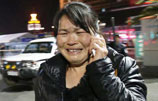London lessons to fight pollution in Chinese cities
Updated: 2014-03-05 08:55
By Murad Qureshhi (China Daily)
|
|||||||||||
One of the top issues on the agenda of the annual sessions of the National People's Congress and the Chinese People's Political Consultative Conference is how to improve the air quality in the country. The record levels of pollution in Chinese cities last week and the World Health Organization's concern over the situation are a stark reminder of the high cost China has paid for economic development.
China, however, can have more blue-sky days by emulating London's battle against the Great Smog of 1952 and the more recent battles against new forms of pollution caused primarily by motor vehicles in which transport management and technology have played significant roles.
The Great Smog of December 1952 is the severest pollution event to have affected London. A period of cold weather, combined with an area of high pressure and windless conditions, created airborne pollutants mostly from burning coal (used both by factories and homes) to form a thick layer of smog over London between Dec 5 and 9. The smog, according to government medical reports, caused the premature death of about 4,000 people and left nearly 100,000 ill. Recent research, however, suggests that the actual number of fatalities was far greater at about 12,000.
In 1956, the British government issued the Clean Air Act to create mandatory smokeless zones in residential areas both in towns and cities, where only authorized fuels could be used for cooking and heating. New regulations were implemented for the industry, too, restricting the use of dirty fuels and banning black smoke. Within just three years the use of coal disappeared from British cities, including London, where people could breath much more easily. Legislation can make a difference - a big difference. But transport management and technology also have important roles to play in the fight against air pollution, especially when the problem in London is not sulfur oxides but nitrogen oxides and PM2.5 (particulate matter with a diameter of 2.5 micrometer or less and extremely harmful to humans). To deal with the problem, a low emission zone was created across the whole of London. The idea was to reduce emissions from heavy and light goods vehicles.
London also imposes congestion charges on drivers, which was originally designed to deal with traffic congestion but has also helped reduce air pollution in central London hotspots. Both policy initiatives were pushed through by the previous London mayor in response to the pollution problem. And the present mayor wants to add an ultra low emission zone to encourage car manufacturers to develop vehicles with zero emissions at the tail pipe, though this is targeted to be operational in 2020.
Related Stories
China considers building smog research facility 2014-03-02 14:37
Beijing vows tough stance on smog 2014-03-02 17:31
China considers building smog research facility 2014-03-02 19:38
China's smog suspended, not terminated 2014-02-28 03:13
Today's Top News
Li opens congress with strong first report
Putin: Force 'last resort' in Ukraine
Obama releases 2015 budget request
Peace quest spurs defense push
Kiev, Moscow start consultations over tensions
Attack prompts strengthened anti-terrorism legislation
Chinese market offers better times for the rich
Last 3 suspects caught in Kunming manhunt
Hot Topics
Lunar probe , China growth forecasts, Emission rules get tougher, China seen through 'colored lens', International board,
Editor's Picks

|

|

|

|

|

|





